Comparative Analysis of Management Accounting Systems: Two Firms
VerifiedAdded on 2022/03/21
|29
|7983
|11
Report
AI Summary
This report provides a comprehensive analysis of the management accounting systems of Coffeegreen Ltd. and Galaxy, exploring how these firms utilize various planning tools to address financial challenges and achieve sustainable success. The analysis begins with an examination of planning tools, including standard costs, budgets, and the balanced scorecard (BSC), outlining their advantages and disadvantages. The report then delves into specific calculations, such as determining the cost of a contract and the standard cost for processed coffee, along with the optimal selling price to maximize revenue. Furthermore, the report includes the preparation of monthly budgets for sales revenue and production resources. It also evaluates how planning tools contribute to Coffeegreen's long-term success and applies PEST, SWOT, and BSC analyses. The report then compares the management accounting systems of both firms, highlighting the characteristics of efficient management accountants and analyzing how management accounting can lead to sustainable success for both Coffeegreen and Galaxy. The report concludes with a discussion of the practical suggestions for improving the accounting system.
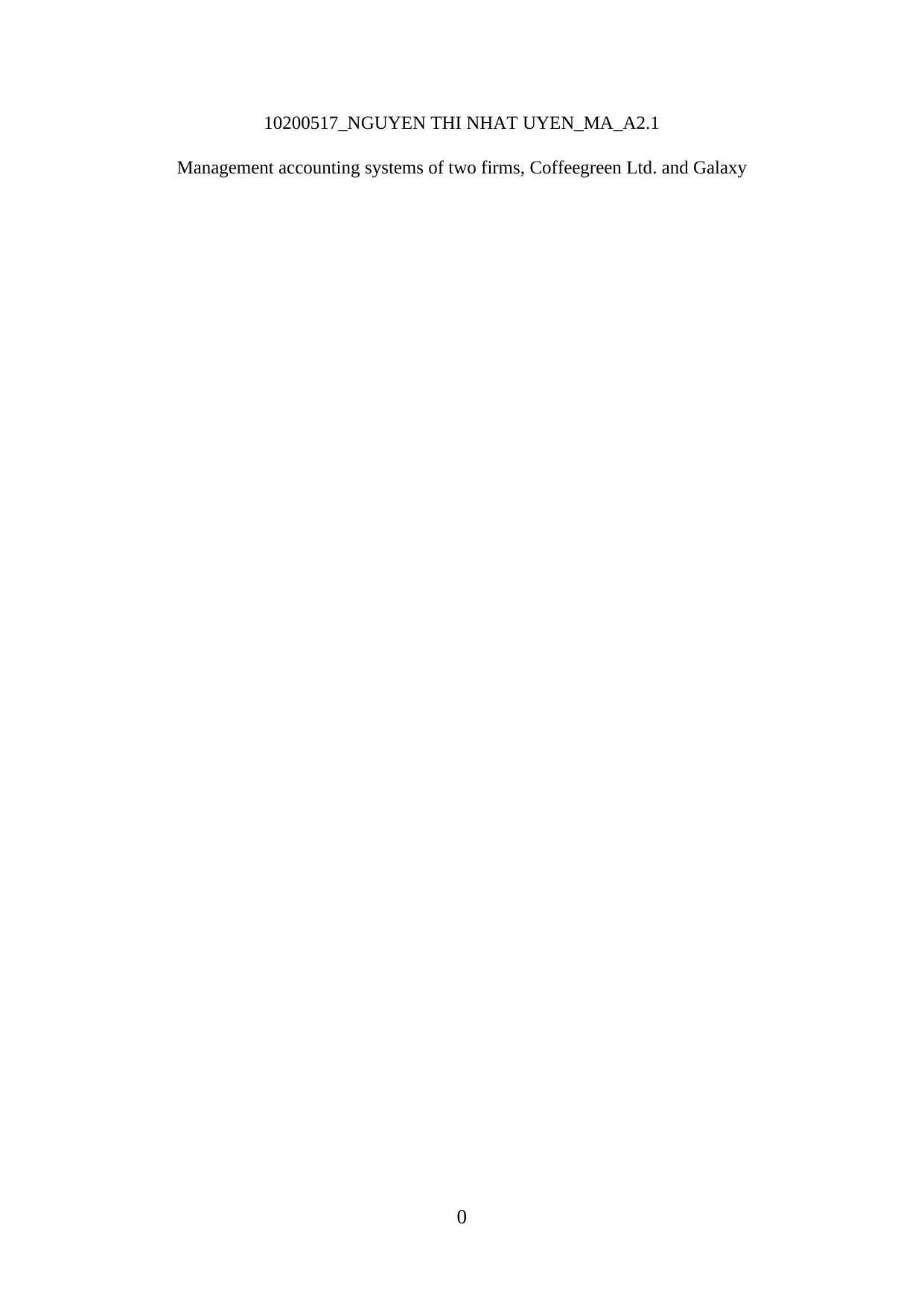
10200517_NGUYEN THI NHAT UYEN_MA_A2.1
Management accounting systems of two firms, Coffeegreen Ltd. and Galaxy
0
Management accounting systems of two firms, Coffeegreen Ltd. and Galaxy
0
Paraphrase This Document
Need a fresh take? Get an instant paraphrase of this document with our AI Paraphraser
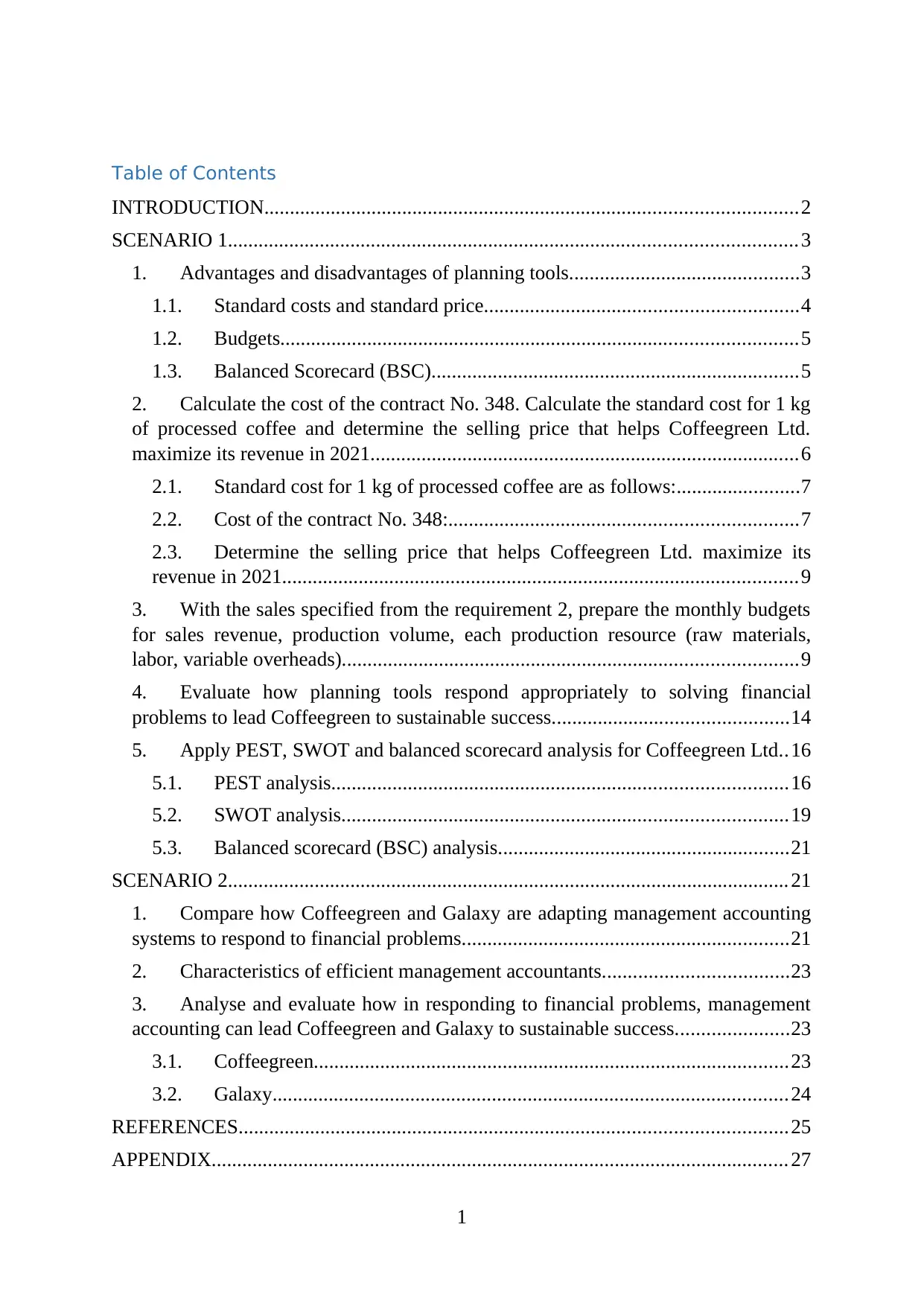
Table of Contents
INTRODUCTION........................................................................................................2
SCENARIO 1...............................................................................................................3
1. Advantages and disadvantages of planning tools.............................................3
1.1. Standard costs and standard price.............................................................4
1.2. Budgets.....................................................................................................5
1.3. Balanced Scorecard (BSC)........................................................................5
2. Calculate the cost of the contract No. 348. Calculate the standard cost for 1 kg
of processed coffee and determine the selling price that helps Coffeegreen Ltd.
maximize its revenue in 2021....................................................................................6
2.1. Standard cost for 1 kg of processed coffee are as follows:........................7
2.2. Cost of the contract No. 348:....................................................................7
2.3. Determine the selling price that helps Coffeegreen Ltd. maximize its
revenue in 2021.....................................................................................................9
3. With the sales specified from the requirement 2, prepare the monthly budgets
for sales revenue, production volume, each production resource (raw materials,
labor, variable overheads).........................................................................................9
4. Evaluate how planning tools respond appropriately to solving financial
problems to lead Coffeegreen to sustainable success..............................................14
5. Apply PEST, SWOT and balanced scorecard analysis for Coffeegreen Ltd..16
5.1. PEST analysis.........................................................................................16
5.2. SWOT analysis.......................................................................................19
5.3. Balanced scorecard (BSC) analysis.........................................................21
SCENARIO 2.............................................................................................................. 21
1. Compare how Coffeegreen and Galaxy are adapting management accounting
systems to respond to financial problems................................................................21
2. Characteristics of efficient management accountants....................................23
3. Analyse and evaluate how in responding to financial problems, management
accounting can lead Coffeegreen and Galaxy to sustainable success......................23
3.1. Coffeegreen.............................................................................................23
3.2. Galaxy.....................................................................................................24
REFERENCES...........................................................................................................25
APPENDIX................................................................................................................. 27
1
INTRODUCTION........................................................................................................2
SCENARIO 1...............................................................................................................3
1. Advantages and disadvantages of planning tools.............................................3
1.1. Standard costs and standard price.............................................................4
1.2. Budgets.....................................................................................................5
1.3. Balanced Scorecard (BSC)........................................................................5
2. Calculate the cost of the contract No. 348. Calculate the standard cost for 1 kg
of processed coffee and determine the selling price that helps Coffeegreen Ltd.
maximize its revenue in 2021....................................................................................6
2.1. Standard cost for 1 kg of processed coffee are as follows:........................7
2.2. Cost of the contract No. 348:....................................................................7
2.3. Determine the selling price that helps Coffeegreen Ltd. maximize its
revenue in 2021.....................................................................................................9
3. With the sales specified from the requirement 2, prepare the monthly budgets
for sales revenue, production volume, each production resource (raw materials,
labor, variable overheads).........................................................................................9
4. Evaluate how planning tools respond appropriately to solving financial
problems to lead Coffeegreen to sustainable success..............................................14
5. Apply PEST, SWOT and balanced scorecard analysis for Coffeegreen Ltd..16
5.1. PEST analysis.........................................................................................16
5.2. SWOT analysis.......................................................................................19
5.3. Balanced scorecard (BSC) analysis.........................................................21
SCENARIO 2.............................................................................................................. 21
1. Compare how Coffeegreen and Galaxy are adapting management accounting
systems to respond to financial problems................................................................21
2. Characteristics of efficient management accountants....................................23
3. Analyse and evaluate how in responding to financial problems, management
accounting can lead Coffeegreen and Galaxy to sustainable success......................23
3.1. Coffeegreen.............................................................................................23
3.2. Galaxy.....................................................................................................24
REFERENCES...........................................................................................................25
APPENDIX................................................................................................................. 27
1
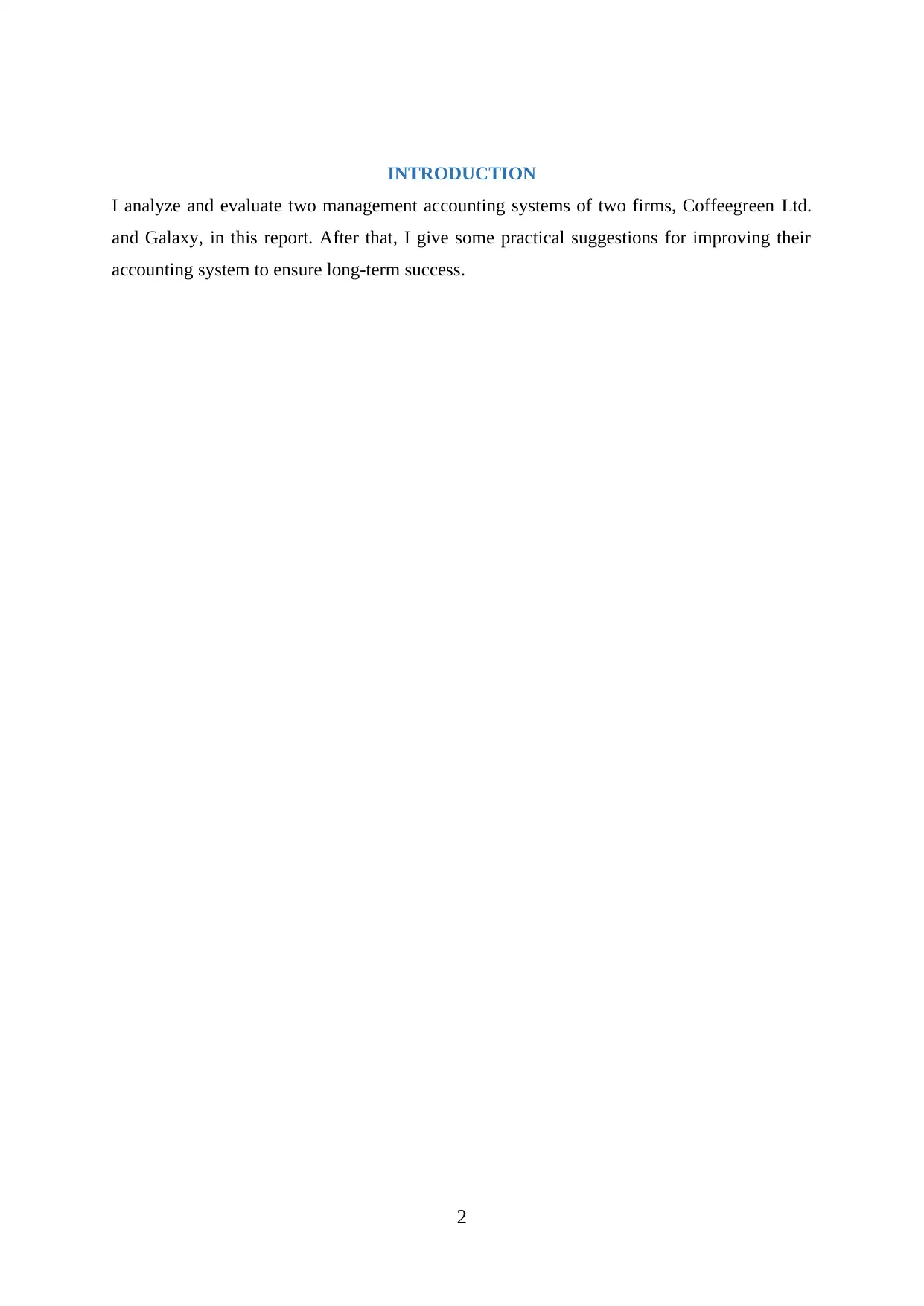
INTRODUCTION
I analyze and evaluate two management accounting systems of two firms, Coffeegreen Ltd.
and Galaxy, in this report. After that, I give some practical suggestions for improving their
accounting system to ensure long-term success.
2
I analyze and evaluate two management accounting systems of two firms, Coffeegreen Ltd.
and Galaxy, in this report. After that, I give some practical suggestions for improving their
accounting system to ensure long-term success.
2
⊘ This is a preview!⊘
Do you want full access?
Subscribe today to unlock all pages.

Trusted by 1+ million students worldwide
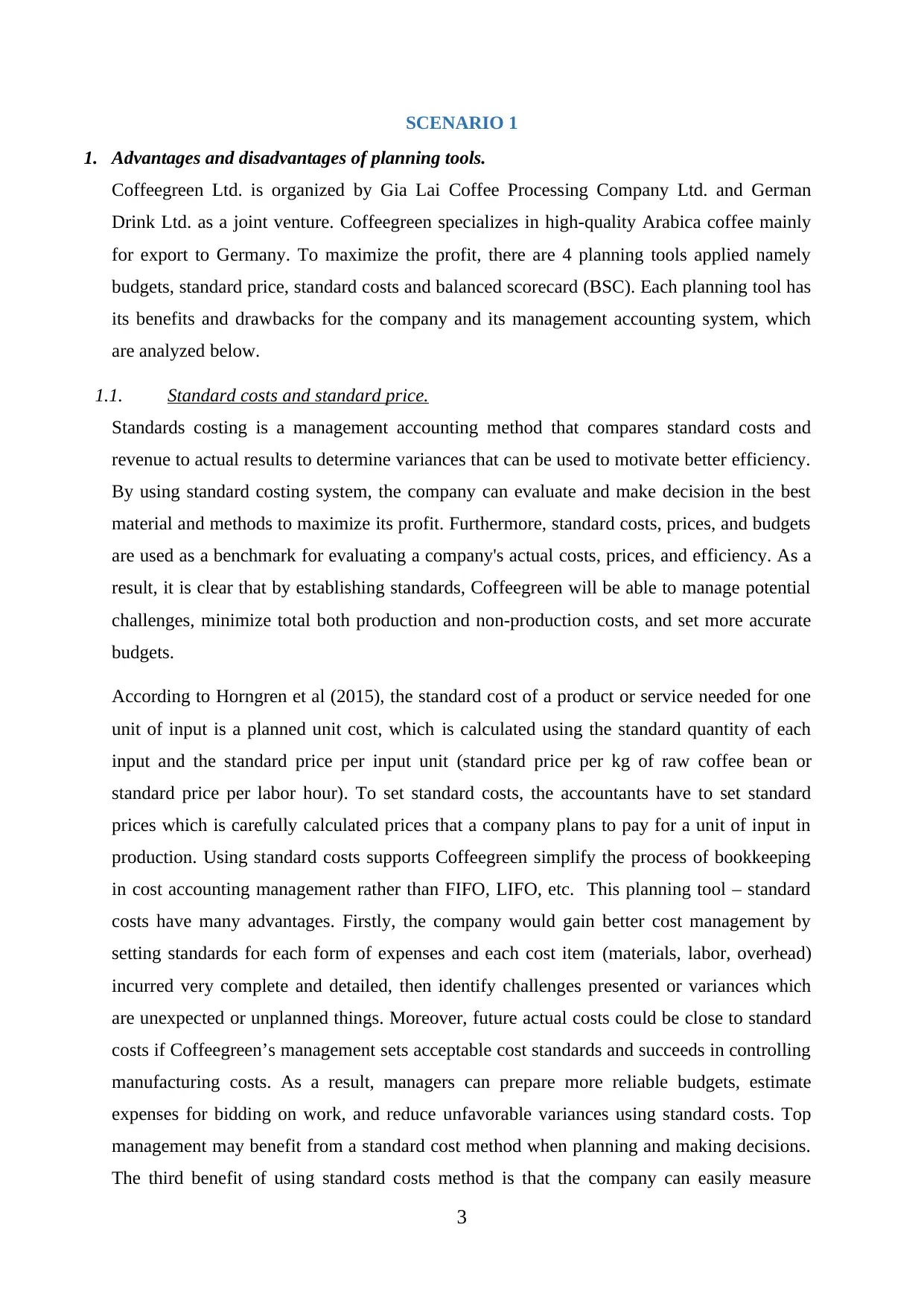
SCENARIO 1
1. Advantages and disadvantages of planning tools.
Coffeegreen Ltd. is organized by Gia Lai Coffee Processing Company Ltd. and German
Drink Ltd. as a joint venture. Coffeegreen specializes in high-quality Arabica coffee mainly
for export to Germany. To maximize the profit, there are 4 planning tools applied namely
budgets, standard price, standard costs and balanced scorecard (BSC). Each planning tool has
its benefits and drawbacks for the company and its management accounting system, which
are analyzed below.
1.1. Standard costs and standard price.
Standards costing is a management accounting method that compares standard costs and
revenue to actual results to determine variances that can be used to motivate better efficiency.
By using standard costing system, the company can evaluate and make decision in the best
material and methods to maximize its profit. Furthermore, standard costs, prices, and budgets
are used as a benchmark for evaluating a company's actual costs, prices, and efficiency. As a
result, it is clear that by establishing standards, Coffeegreen will be able to manage potential
challenges, minimize total both production and non-production costs, and set more accurate
budgets.
According to Horngren et al (2015), the standard cost of a product or service needed for one
unit of input is a planned unit cost, which is calculated using the standard quantity of each
input and the standard price per input unit (standard price per kg of raw coffee bean or
standard price per labor hour). To set standard costs, the accountants have to set standard
prices which is carefully calculated prices that a company plans to pay for a unit of input in
production. Using standard costs supports Coffeegreen simplify the process of bookkeeping
in cost accounting management rather than FIFO, LIFO, etc. This planning tool – standard
costs have many advantages. Firstly, the company would gain better cost management by
setting standards for each form of expenses and each cost item (materials, labor, overhead)
incurred very complete and detailed, then identify challenges presented or variances which
are unexpected or unplanned things. Moreover, future actual costs could be close to standard
costs if Coffeegreen’s management sets acceptable cost standards and succeeds in controlling
manufacturing costs. As a result, managers can prepare more reliable budgets, estimate
expenses for bidding on work, and reduce unfavorable variances using standard costs. Top
management may benefit from a standard cost method when planning and making decisions.
The third benefit of using standard costs method is that the company can easily measure
3
1. Advantages and disadvantages of planning tools.
Coffeegreen Ltd. is organized by Gia Lai Coffee Processing Company Ltd. and German
Drink Ltd. as a joint venture. Coffeegreen specializes in high-quality Arabica coffee mainly
for export to Germany. To maximize the profit, there are 4 planning tools applied namely
budgets, standard price, standard costs and balanced scorecard (BSC). Each planning tool has
its benefits and drawbacks for the company and its management accounting system, which
are analyzed below.
1.1. Standard costs and standard price.
Standards costing is a management accounting method that compares standard costs and
revenue to actual results to determine variances that can be used to motivate better efficiency.
By using standard costing system, the company can evaluate and make decision in the best
material and methods to maximize its profit. Furthermore, standard costs, prices, and budgets
are used as a benchmark for evaluating a company's actual costs, prices, and efficiency. As a
result, it is clear that by establishing standards, Coffeegreen will be able to manage potential
challenges, minimize total both production and non-production costs, and set more accurate
budgets.
According to Horngren et al (2015), the standard cost of a product or service needed for one
unit of input is a planned unit cost, which is calculated using the standard quantity of each
input and the standard price per input unit (standard price per kg of raw coffee bean or
standard price per labor hour). To set standard costs, the accountants have to set standard
prices which is carefully calculated prices that a company plans to pay for a unit of input in
production. Using standard costs supports Coffeegreen simplify the process of bookkeeping
in cost accounting management rather than FIFO, LIFO, etc. This planning tool – standard
costs have many advantages. Firstly, the company would gain better cost management by
setting standards for each form of expenses and each cost item (materials, labor, overhead)
incurred very complete and detailed, then identify challenges presented or variances which
are unexpected or unplanned things. Moreover, future actual costs could be close to standard
costs if Coffeegreen’s management sets acceptable cost standards and succeeds in controlling
manufacturing costs. As a result, managers can prepare more reliable budgets, estimate
expenses for bidding on work, and reduce unfavorable variances using standard costs. Top
management may benefit from a standard cost method when planning and making decisions.
The third benefit of using standard costs method is that the company can easily measure
3
Paraphrase This Document
Need a fresh take? Get an instant paraphrase of this document with our AI Paraphraser
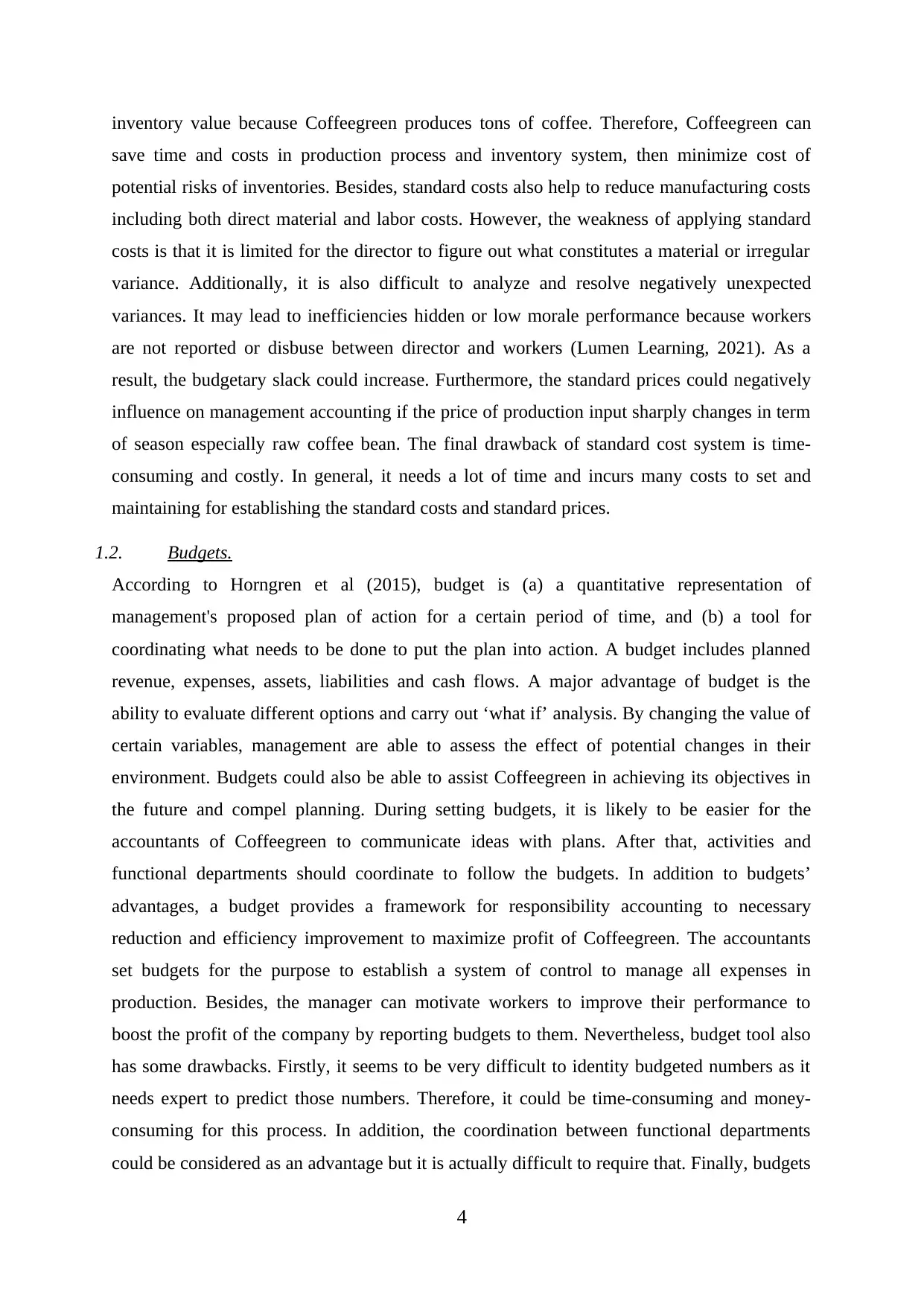
inventory value because Coffeegreen produces tons of coffee. Therefore, Coffeegreen can
save time and costs in production process and inventory system, then minimize cost of
potential risks of inventories. Besides, standard costs also help to reduce manufacturing costs
including both direct material and labor costs. However, the weakness of applying standard
costs is that it is limited for the director to figure out what constitutes a material or irregular
variance. Additionally, it is also difficult to analyze and resolve negatively unexpected
variances. It may lead to inefficiencies hidden or low morale performance because workers
are not reported or disbuse between director and workers (Lumen Learning, 2021). As a
result, the budgetary slack could increase. Furthermore, the standard prices could negatively
influence on management accounting if the price of production input sharply changes in term
of season especially raw coffee bean. The final drawback of standard cost system is time-
consuming and costly. In general, it needs a lot of time and incurs many costs to set and
maintaining for establishing the standard costs and standard prices.
1.2. Budgets.
According to Horngren et al (2015), budget is (a) a quantitative representation of
management's proposed plan of action for a certain period of time, and (b) a tool for
coordinating what needs to be done to put the plan into action. A budget includes planned
revenue, expenses, assets, liabilities and cash flows. A major advantage of budget is the
ability to evaluate different options and carry out ‘what if’ analysis. By changing the value of
certain variables, management are able to assess the effect of potential changes in their
environment. Budgets could also be able to assist Coffeegreen in achieving its objectives in
the future and compel planning. During setting budgets, it is likely to be easier for the
accountants of Coffeegreen to communicate ideas with plans. After that, activities and
functional departments should coordinate to follow the budgets. In addition to budgets’
advantages, a budget provides a framework for responsibility accounting to necessary
reduction and efficiency improvement to maximize profit of Coffeegreen. The accountants
set budgets for the purpose to establish a system of control to manage all expenses in
production. Besides, the manager can motivate workers to improve their performance to
boost the profit of the company by reporting budgets to them. Nevertheless, budget tool also
has some drawbacks. Firstly, it seems to be very difficult to identity budgeted numbers as it
needs expert to predict those numbers. Therefore, it could be time-consuming and money-
consuming for this process. In addition, the coordination between functional departments
could be considered as an advantage but it is actually difficult to require that. Finally, budgets
4
save time and costs in production process and inventory system, then minimize cost of
potential risks of inventories. Besides, standard costs also help to reduce manufacturing costs
including both direct material and labor costs. However, the weakness of applying standard
costs is that it is limited for the director to figure out what constitutes a material or irregular
variance. Additionally, it is also difficult to analyze and resolve negatively unexpected
variances. It may lead to inefficiencies hidden or low morale performance because workers
are not reported or disbuse between director and workers (Lumen Learning, 2021). As a
result, the budgetary slack could increase. Furthermore, the standard prices could negatively
influence on management accounting if the price of production input sharply changes in term
of season especially raw coffee bean. The final drawback of standard cost system is time-
consuming and costly. In general, it needs a lot of time and incurs many costs to set and
maintaining for establishing the standard costs and standard prices.
1.2. Budgets.
According to Horngren et al (2015), budget is (a) a quantitative representation of
management's proposed plan of action for a certain period of time, and (b) a tool for
coordinating what needs to be done to put the plan into action. A budget includes planned
revenue, expenses, assets, liabilities and cash flows. A major advantage of budget is the
ability to evaluate different options and carry out ‘what if’ analysis. By changing the value of
certain variables, management are able to assess the effect of potential changes in their
environment. Budgets could also be able to assist Coffeegreen in achieving its objectives in
the future and compel planning. During setting budgets, it is likely to be easier for the
accountants of Coffeegreen to communicate ideas with plans. After that, activities and
functional departments should coordinate to follow the budgets. In addition to budgets’
advantages, a budget provides a framework for responsibility accounting to necessary
reduction and efficiency improvement to maximize profit of Coffeegreen. The accountants
set budgets for the purpose to establish a system of control to manage all expenses in
production. Besides, the manager can motivate workers to improve their performance to
boost the profit of the company by reporting budgets to them. Nevertheless, budget tool also
has some drawbacks. Firstly, it seems to be very difficult to identity budgeted numbers as it
needs expert to predict those numbers. Therefore, it could be time-consuming and money-
consuming for this process. In addition, the coordination between functional departments
could be considered as an advantage but it is actually difficult to require that. Finally, budgets
4
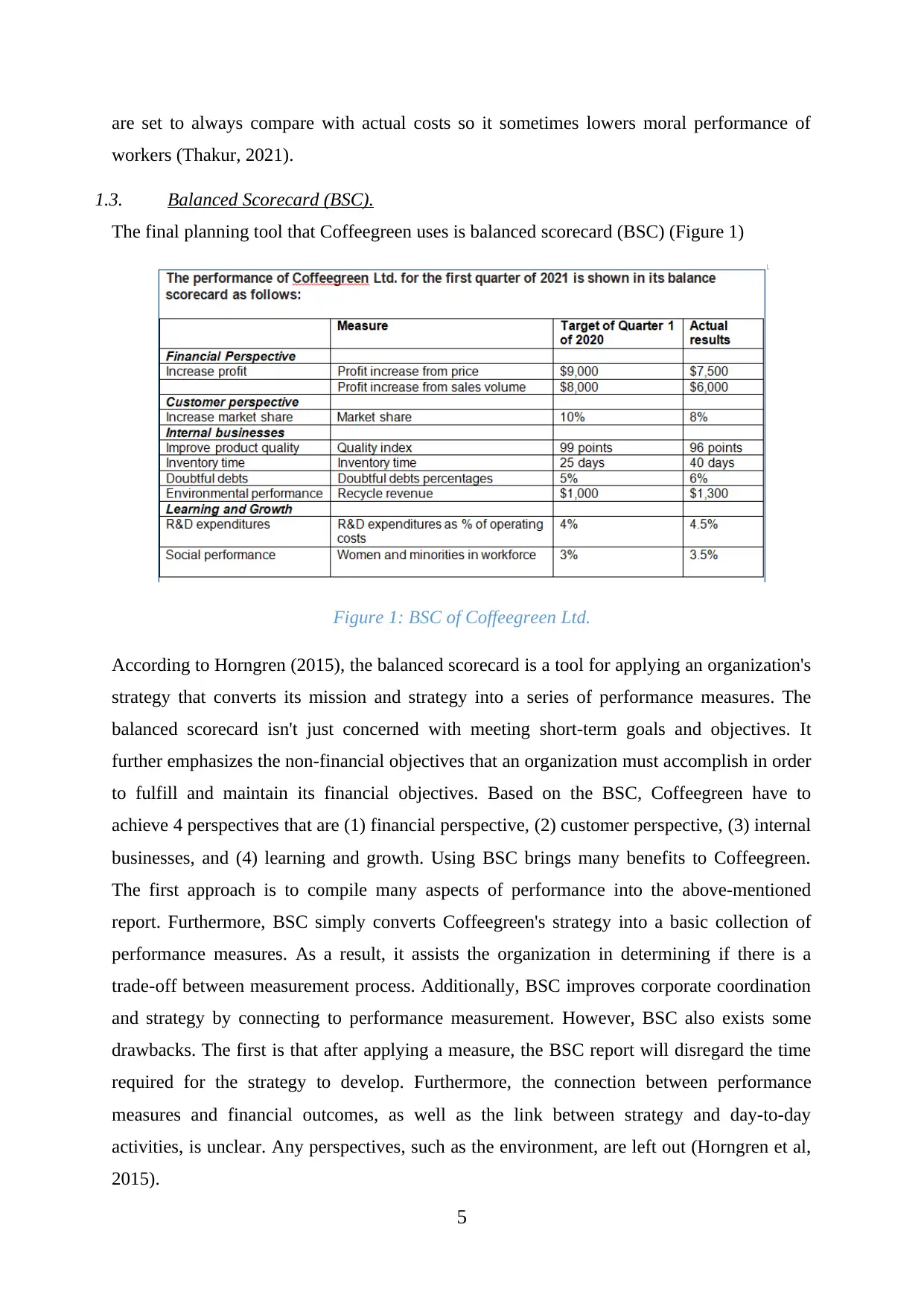
are set to always compare with actual costs so it sometimes lowers moral performance of
workers (Thakur, 2021).
1.3. Balanced Scorecard (BSC).
The final planning tool that Coffeegreen uses is balanced scorecard (BSC) (Figure 1)
Figure 1: BSC of Coffeegreen Ltd.
According to Horngren (2015), the balanced scorecard is a tool for applying an organization's
strategy that converts its mission and strategy into a series of performance measures. The
balanced scorecard isn't just concerned with meeting short-term goals and objectives. It
further emphasizes the non-financial objectives that an organization must accomplish in order
to fulfill and maintain its financial objectives. Based on the BSC, Coffeegreen have to
achieve 4 perspectives that are (1) financial perspective, (2) customer perspective, (3) internal
businesses, and (4) learning and growth. Using BSC brings many benefits to Coffeegreen.
The first approach is to compile many aspects of performance into the above-mentioned
report. Furthermore, BSC simply converts Coffeegreen's strategy into a basic collection of
performance measures. As a result, it assists the organization in determining if there is a
trade-off between measurement process. Additionally, BSC improves corporate coordination
and strategy by connecting to performance measurement. However, BSC also exists some
drawbacks. The first is that after applying a measure, the BSC report will disregard the time
required for the strategy to develop. Furthermore, the connection between performance
measures and financial outcomes, as well as the link between strategy and day-to-day
activities, is unclear. Any perspectives, such as the environment, are left out (Horngren et al,
2015).
5
workers (Thakur, 2021).
1.3. Balanced Scorecard (BSC).
The final planning tool that Coffeegreen uses is balanced scorecard (BSC) (Figure 1)
Figure 1: BSC of Coffeegreen Ltd.
According to Horngren (2015), the balanced scorecard is a tool for applying an organization's
strategy that converts its mission and strategy into a series of performance measures. The
balanced scorecard isn't just concerned with meeting short-term goals and objectives. It
further emphasizes the non-financial objectives that an organization must accomplish in order
to fulfill and maintain its financial objectives. Based on the BSC, Coffeegreen have to
achieve 4 perspectives that are (1) financial perspective, (2) customer perspective, (3) internal
businesses, and (4) learning and growth. Using BSC brings many benefits to Coffeegreen.
The first approach is to compile many aspects of performance into the above-mentioned
report. Furthermore, BSC simply converts Coffeegreen's strategy into a basic collection of
performance measures. As a result, it assists the organization in determining if there is a
trade-off between measurement process. Additionally, BSC improves corporate coordination
and strategy by connecting to performance measurement. However, BSC also exists some
drawbacks. The first is that after applying a measure, the BSC report will disregard the time
required for the strategy to develop. Furthermore, the connection between performance
measures and financial outcomes, as well as the link between strategy and day-to-day
activities, is unclear. Any perspectives, such as the environment, are left out (Horngren et al,
2015).
5
⊘ This is a preview!⊘
Do you want full access?
Subscribe today to unlock all pages.

Trusted by 1+ million students worldwide
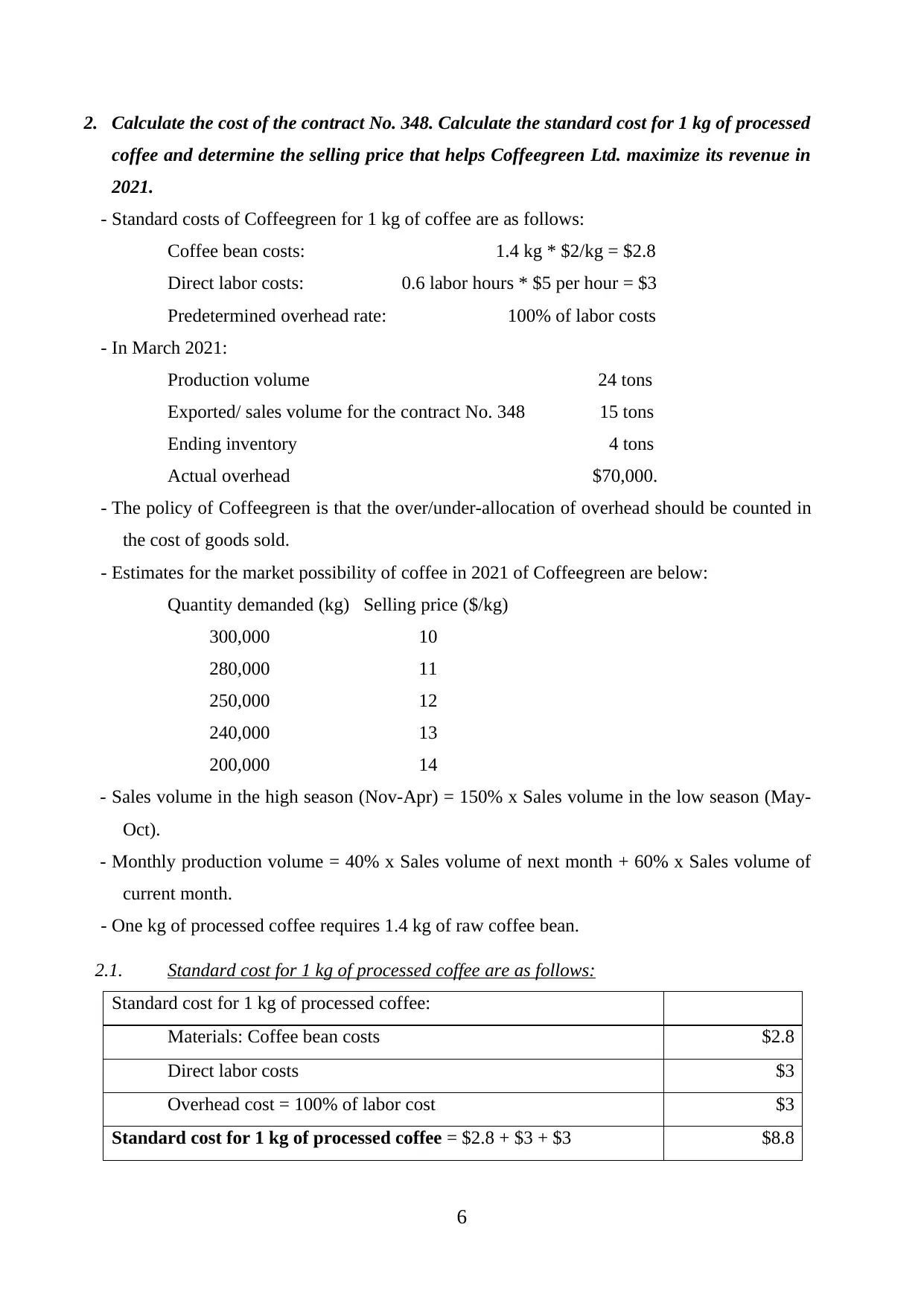
2. Calculate the cost of the contract No. 348. Calculate the standard cost for 1 kg of processed
coffee and determine the selling price that helps Coffeegreen Ltd. maximize its revenue in
2021.
- Standard costs of Coffeegreen for 1 kg of coffee are as follows:
Coffee bean costs: 1.4 kg * $2/kg = $2.8
Direct labor costs: 0.6 labor hours * $5 per hour = $3
Predetermined overhead rate: 100% of labor costs
- In March 2021:
Production volume 24 tons
Exported/ sales volume for the contract No. 348 15 tons
Ending inventory 4 tons
Actual overhead $70,000.
- The policy of Coffeegreen is that the over/under-allocation of overhead should be counted in
the cost of goods sold.
- Estimates for the market possibility of coffee in 2021 of Coffeegreen are below:
Quantity demanded (kg) Selling price ($/kg)
300,000 10
280,000 11
250,000 12
240,000 13
200,000 14
- Sales volume in the high season (Nov-Apr) = 150% x Sales volume in the low season (May-
Oct).
- Monthly production volume = 40% x Sales volume of next month + 60% x Sales volume of
current month.
- One kg of processed coffee requires 1.4 kg of raw coffee bean.
2.1. Standard cost for 1 kg of processed coffee are as follows:
Standard cost for 1 kg of processed coffee:
Materials: Coffee bean costs $2.8
Direct labor costs $3
Overhead cost = 100% of labor cost $3
Standard cost for 1 kg of processed coffee = $2.8 + $3 + $3 $8.8
6
coffee and determine the selling price that helps Coffeegreen Ltd. maximize its revenue in
2021.
- Standard costs of Coffeegreen for 1 kg of coffee are as follows:
Coffee bean costs: 1.4 kg * $2/kg = $2.8
Direct labor costs: 0.6 labor hours * $5 per hour = $3
Predetermined overhead rate: 100% of labor costs
- In March 2021:
Production volume 24 tons
Exported/ sales volume for the contract No. 348 15 tons
Ending inventory 4 tons
Actual overhead $70,000.
- The policy of Coffeegreen is that the over/under-allocation of overhead should be counted in
the cost of goods sold.
- Estimates for the market possibility of coffee in 2021 of Coffeegreen are below:
Quantity demanded (kg) Selling price ($/kg)
300,000 10
280,000 11
250,000 12
240,000 13
200,000 14
- Sales volume in the high season (Nov-Apr) = 150% x Sales volume in the low season (May-
Oct).
- Monthly production volume = 40% x Sales volume of next month + 60% x Sales volume of
current month.
- One kg of processed coffee requires 1.4 kg of raw coffee bean.
2.1. Standard cost for 1 kg of processed coffee are as follows:
Standard cost for 1 kg of processed coffee:
Materials: Coffee bean costs $2.8
Direct labor costs $3
Overhead cost = 100% of labor cost $3
Standard cost for 1 kg of processed coffee = $2.8 + $3 + $3 $8.8
6
Paraphrase This Document
Need a fresh take? Get an instant paraphrase of this document with our AI Paraphraser
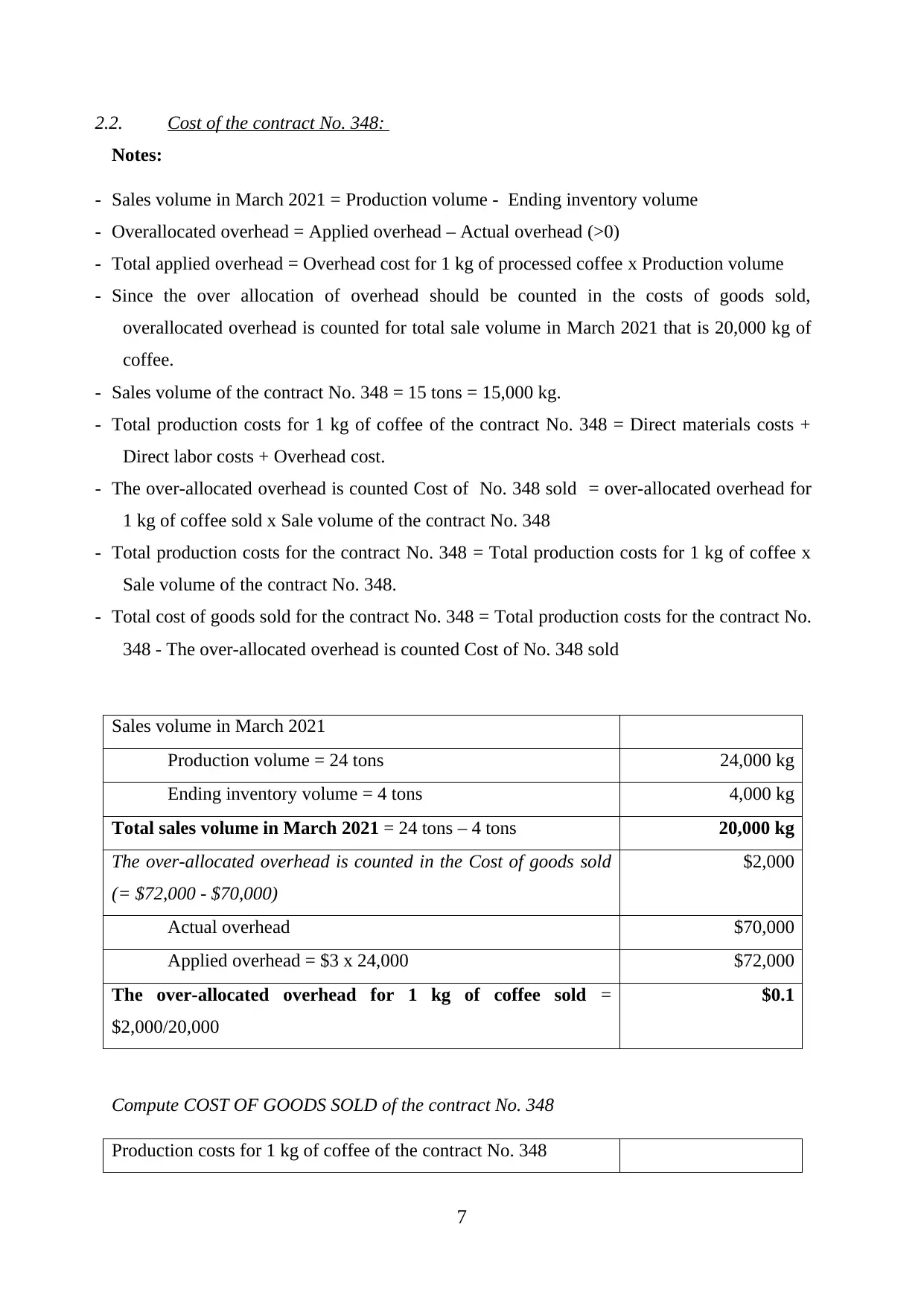
2.2. Cost of the contract No. 348:
Notes:
- Sales volume in March 2021 = Production volume - Ending inventory volume
- Overallocated overhead = Applied overhead – Actual overhead (>0)
- Total applied overhead = Overhead cost for 1 kg of processed coffee x Production volume
- Since the over allocation of overhead should be counted in the costs of goods sold,
overallocated overhead is counted for total sale volume in March 2021 that is 20,000 kg of
coffee.
- Sales volume of the contract No. 348 = 15 tons = 15,000 kg.
- Total production costs for 1 kg of coffee of the contract No. 348 = Direct materials costs +
Direct labor costs + Overhead cost.
- The over-allocated overhead is counted Cost of No. 348 sold = over-allocated overhead for
1 kg of coffee sold x Sale volume of the contract No. 348
- Total production costs for the contract No. 348 = Total production costs for 1 kg of coffee x
Sale volume of the contract No. 348.
- Total cost of goods sold for the contract No. 348 = Total production costs for the contract No.
348 - The over-allocated overhead is counted Cost of No. 348 sold
Sales volume in March 2021
Production volume = 24 tons 24,000 kg
Ending inventory volume = 4 tons 4,000 kg
Total sales volume in March 2021 = 24 tons – 4 tons 20,000 kg
The over-allocated overhead is counted in the Cost of goods sold
(= $72,000 - $70,000)
$2,000
Actual overhead $70,000
Applied overhead = $3 x 24,000 $72,000
The over-allocated overhead for 1 kg of coffee sold =
$2,000/20,000
$0.1
Compute COST OF GOODS SOLD of the contract No. 348
Production costs for 1 kg of coffee of the contract No. 348
7
Notes:
- Sales volume in March 2021 = Production volume - Ending inventory volume
- Overallocated overhead = Applied overhead – Actual overhead (>0)
- Total applied overhead = Overhead cost for 1 kg of processed coffee x Production volume
- Since the over allocation of overhead should be counted in the costs of goods sold,
overallocated overhead is counted for total sale volume in March 2021 that is 20,000 kg of
coffee.
- Sales volume of the contract No. 348 = 15 tons = 15,000 kg.
- Total production costs for 1 kg of coffee of the contract No. 348 = Direct materials costs +
Direct labor costs + Overhead cost.
- The over-allocated overhead is counted Cost of No. 348 sold = over-allocated overhead for
1 kg of coffee sold x Sale volume of the contract No. 348
- Total production costs for the contract No. 348 = Total production costs for 1 kg of coffee x
Sale volume of the contract No. 348.
- Total cost of goods sold for the contract No. 348 = Total production costs for the contract No.
348 - The over-allocated overhead is counted Cost of No. 348 sold
Sales volume in March 2021
Production volume = 24 tons 24,000 kg
Ending inventory volume = 4 tons 4,000 kg
Total sales volume in March 2021 = 24 tons – 4 tons 20,000 kg
The over-allocated overhead is counted in the Cost of goods sold
(= $72,000 - $70,000)
$2,000
Actual overhead $70,000
Applied overhead = $3 x 24,000 $72,000
The over-allocated overhead for 1 kg of coffee sold =
$2,000/20,000
$0.1
Compute COST OF GOODS SOLD of the contract No. 348
Production costs for 1 kg of coffee of the contract No. 348
7
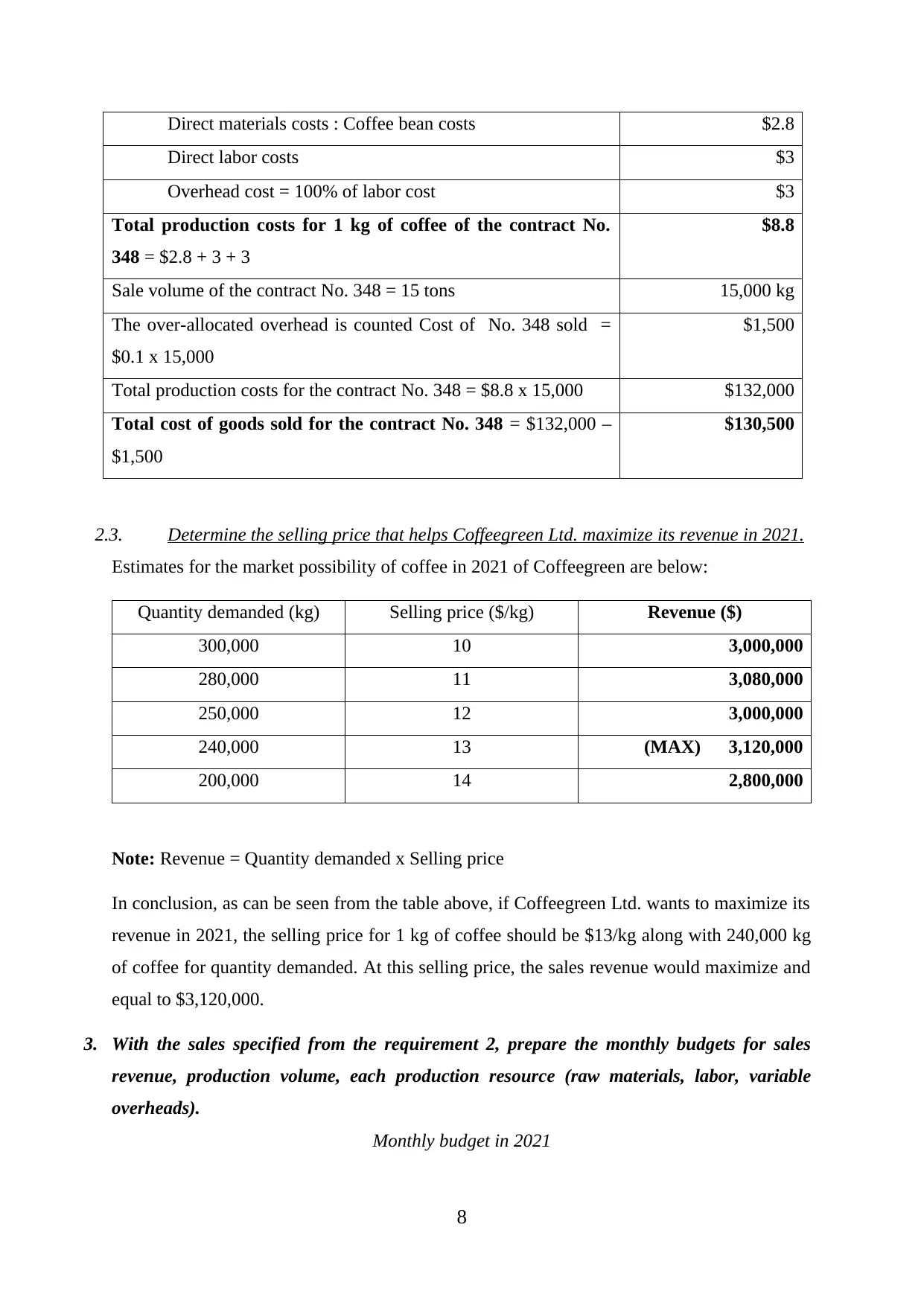
Direct materials costs : Coffee bean costs $2.8
Direct labor costs $3
Overhead cost = 100% of labor cost $3
Total production costs for 1 kg of coffee of the contract No.
348 = $2.8 + 3 + 3
$8.8
Sale volume of the contract No. 348 = 15 tons 15,000 kg
The over-allocated overhead is counted Cost of No. 348 sold =
$0.1 x 15,000
$1,500
Total production costs for the contract No. 348 = $8.8 x 15,000 $132,000
Total cost of goods sold for the contract No. 348 = $132,000 –
$1,500
$130,500
2.3. Determine the selling price that helps Coffeegreen Ltd. maximize its revenue in 2021.
Estimates for the market possibility of coffee in 2021 of Coffeegreen are below:
Quantity demanded (kg) Selling price ($/kg) Revenue ($)
300,000 10 3,000,000
280,000 11 3,080,000
250,000 12 3,000,000
240,000 13 (MAX) 3,120,000
200,000 14 2,800,000
Note: Revenue = Quantity demanded x Selling price
In conclusion, as can be seen from the table above, if Coffeegreen Ltd. wants to maximize its
revenue in 2021, the selling price for 1 kg of coffee should be $13/kg along with 240,000 kg
of coffee for quantity demanded. At this selling price, the sales revenue would maximize and
equal to $3,120,000.
3. With the sales specified from the requirement 2, prepare the monthly budgets for sales
revenue, production volume, each production resource (raw materials, labor, variable
overheads).
Monthly budget in 2021
8
Direct labor costs $3
Overhead cost = 100% of labor cost $3
Total production costs for 1 kg of coffee of the contract No.
348 = $2.8 + 3 + 3
$8.8
Sale volume of the contract No. 348 = 15 tons 15,000 kg
The over-allocated overhead is counted Cost of No. 348 sold =
$0.1 x 15,000
$1,500
Total production costs for the contract No. 348 = $8.8 x 15,000 $132,000
Total cost of goods sold for the contract No. 348 = $132,000 –
$1,500
$130,500
2.3. Determine the selling price that helps Coffeegreen Ltd. maximize its revenue in 2021.
Estimates for the market possibility of coffee in 2021 of Coffeegreen are below:
Quantity demanded (kg) Selling price ($/kg) Revenue ($)
300,000 10 3,000,000
280,000 11 3,080,000
250,000 12 3,000,000
240,000 13 (MAX) 3,120,000
200,000 14 2,800,000
Note: Revenue = Quantity demanded x Selling price
In conclusion, as can be seen from the table above, if Coffeegreen Ltd. wants to maximize its
revenue in 2021, the selling price for 1 kg of coffee should be $13/kg along with 240,000 kg
of coffee for quantity demanded. At this selling price, the sales revenue would maximize and
equal to $3,120,000.
3. With the sales specified from the requirement 2, prepare the monthly budgets for sales
revenue, production volume, each production resource (raw materials, labor, variable
overheads).
Monthly budget in 2021
8
⊘ This is a preview!⊘
Do you want full access?
Subscribe today to unlock all pages.

Trusted by 1+ million students worldwide
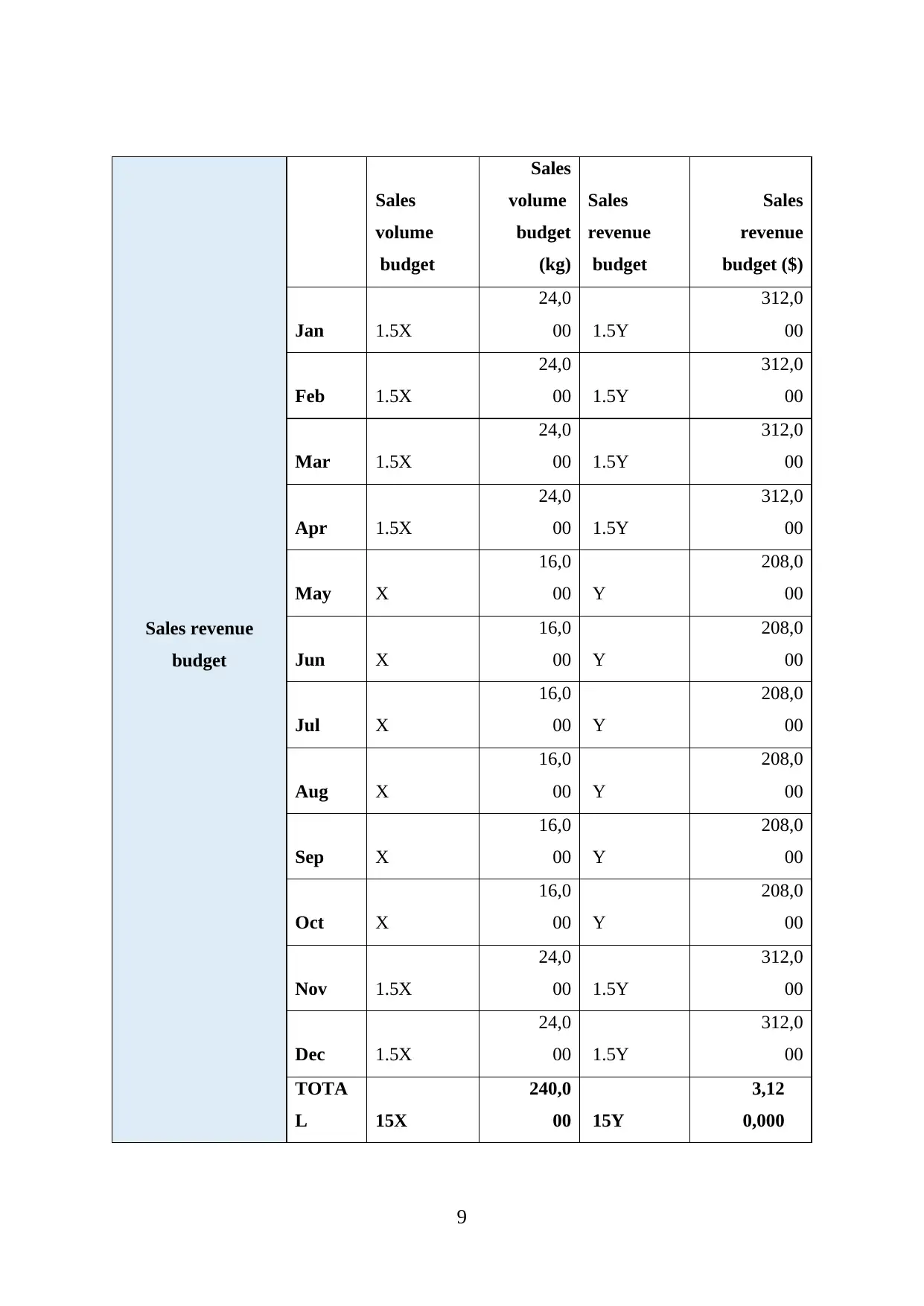
Sales revenue
budget
Sales
volume
budget
Sales
volume
budget
(kg)
Sales
revenue
budget
Sales
revenue
budget ($)
Jan 1.5X
24,0
00 1.5Y
312,0
00
Feb 1.5X
24,0
00 1.5Y
312,0
00
Mar 1.5X
24,0
00 1.5Y
312,0
00
Apr 1.5X
24,0
00 1.5Y
312,0
00
May X
16,0
00 Y
208,0
00
Jun X
16,0
00 Y
208,0
00
Jul X
16,0
00 Y
208,0
00
Aug X
16,0
00 Y
208,0
00
Sep X
16,0
00 Y
208,0
00
Oct X
16,0
00 Y
208,0
00
Nov 1.5X
24,0
00 1.5Y
312,0
00
Dec 1.5X
24,0
00 1.5Y
312,0
00
TOTA
L 15X
240,0
00 15Y
3,12
0,000
9
budget
Sales
volume
budget
Sales
volume
budget
(kg)
Sales
revenue
budget
Sales
revenue
budget ($)
Jan 1.5X
24,0
00 1.5Y
312,0
00
Feb 1.5X
24,0
00 1.5Y
312,0
00
Mar 1.5X
24,0
00 1.5Y
312,0
00
Apr 1.5X
24,0
00 1.5Y
312,0
00
May X
16,0
00 Y
208,0
00
Jun X
16,0
00 Y
208,0
00
Jul X
16,0
00 Y
208,0
00
Aug X
16,0
00 Y
208,0
00
Sep X
16,0
00 Y
208,0
00
Oct X
16,0
00 Y
208,0
00
Nov 1.5X
24,0
00 1.5Y
312,0
00
Dec 1.5X
24,0
00 1.5Y
312,0
00
TOTA
L 15X
240,0
00 15Y
3,12
0,000
9
Paraphrase This Document
Need a fresh take? Get an instant paraphrase of this document with our AI Paraphraser
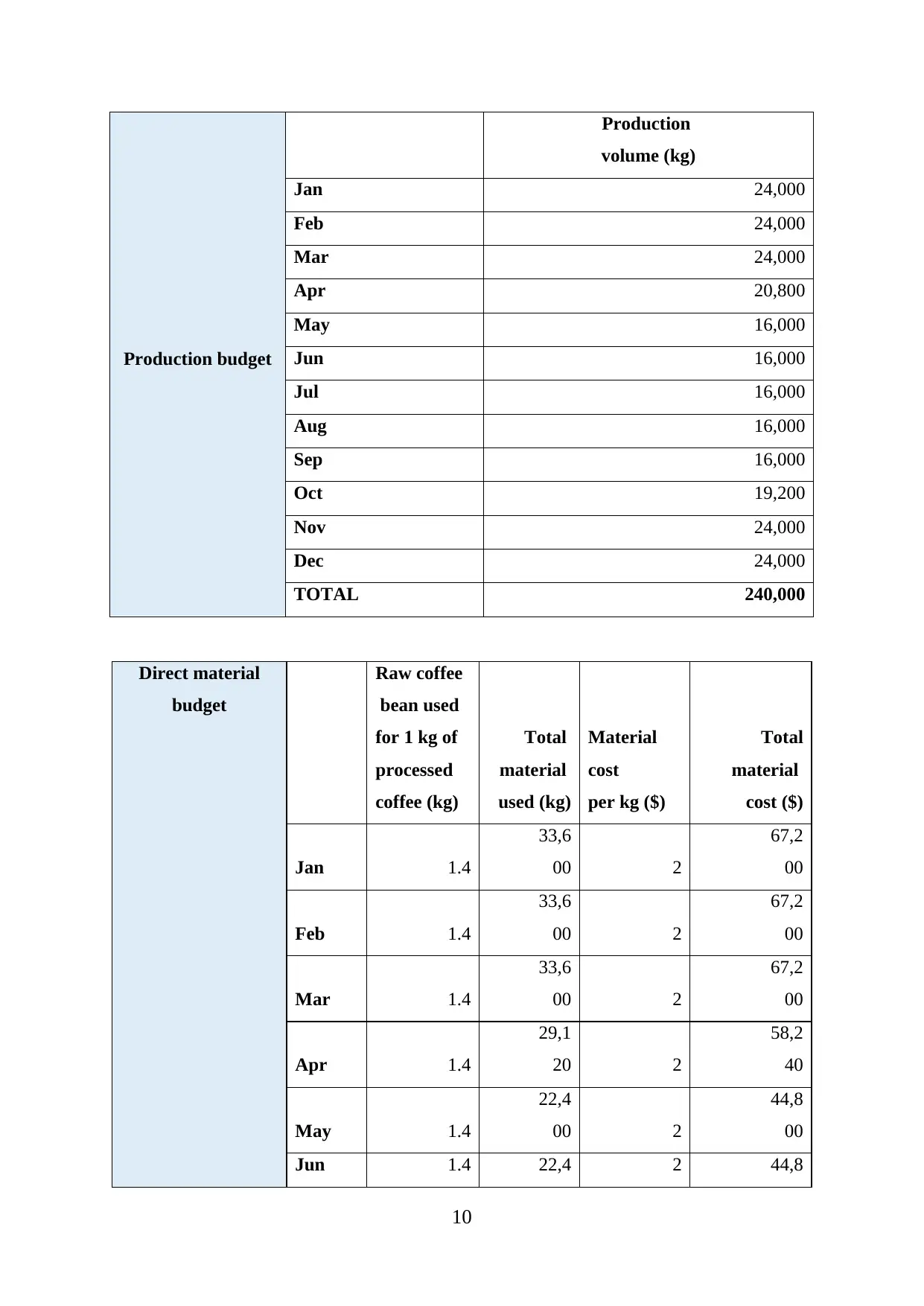
Production budget
Production
volume (kg)
Jan 24,000
Feb 24,000
Mar 24,000
Apr 20,800
May 16,000
Jun 16,000
Jul 16,000
Aug 16,000
Sep 16,000
Oct 19,200
Nov 24,000
Dec 24,000
TOTAL 240,000
Direct material
budget
Raw coffee
bean used
for 1 kg of
processed
coffee (kg)
Total
material
used (kg)
Material
cost
per kg ($)
Total
material
cost ($)
Jan 1.4
33,6
00 2
67,2
00
Feb 1.4
33,6
00 2
67,2
00
Mar 1.4
33,6
00 2
67,2
00
Apr 1.4
29,1
20 2
58,2
40
May 1.4
22,4
00 2
44,8
00
Jun 1.4 22,4 2 44,8
10
Production
volume (kg)
Jan 24,000
Feb 24,000
Mar 24,000
Apr 20,800
May 16,000
Jun 16,000
Jul 16,000
Aug 16,000
Sep 16,000
Oct 19,200
Nov 24,000
Dec 24,000
TOTAL 240,000
Direct material
budget
Raw coffee
bean used
for 1 kg of
processed
coffee (kg)
Total
material
used (kg)
Material
cost
per kg ($)
Total
material
cost ($)
Jan 1.4
33,6
00 2
67,2
00
Feb 1.4
33,6
00 2
67,2
00
Mar 1.4
33,6
00 2
67,2
00
Apr 1.4
29,1
20 2
58,2
40
May 1.4
22,4
00 2
44,8
00
Jun 1.4 22,4 2 44,8
10
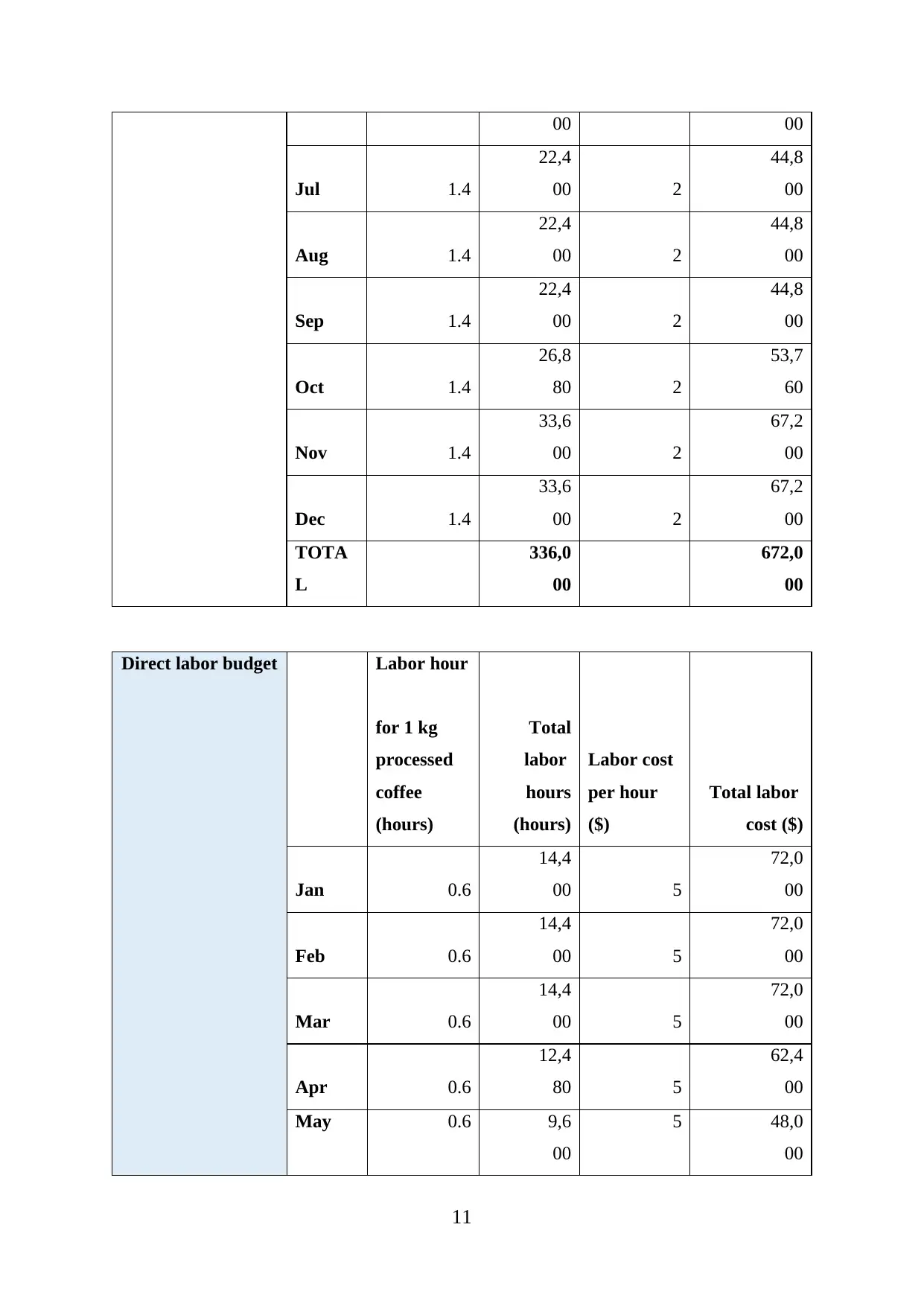
00 00
Jul 1.4
22,4
00 2
44,8
00
Aug 1.4
22,4
00 2
44,8
00
Sep 1.4
22,4
00 2
44,8
00
Oct 1.4
26,8
80 2
53,7
60
Nov 1.4
33,6
00 2
67,2
00
Dec 1.4
33,6
00 2
67,2
00
TOTA
L
336,0
00
672,0
00
Direct labor budget Labor hour
for 1 kg
processed
coffee
(hours)
Total
labor
hours
(hours)
Labor cost
per hour
($)
Total labor
cost ($)
Jan 0.6
14,4
00 5
72,0
00
Feb 0.6
14,4
00 5
72,0
00
Mar 0.6
14,4
00 5
72,0
00
Apr 0.6
12,4
80 5
62,4
00
May 0.6 9,6
00
5 48,0
00
11
Jul 1.4
22,4
00 2
44,8
00
Aug 1.4
22,4
00 2
44,8
00
Sep 1.4
22,4
00 2
44,8
00
Oct 1.4
26,8
80 2
53,7
60
Nov 1.4
33,6
00 2
67,2
00
Dec 1.4
33,6
00 2
67,2
00
TOTA
L
336,0
00
672,0
00
Direct labor budget Labor hour
for 1 kg
processed
coffee
(hours)
Total
labor
hours
(hours)
Labor cost
per hour
($)
Total labor
cost ($)
Jan 0.6
14,4
00 5
72,0
00
Feb 0.6
14,4
00 5
72,0
00
Mar 0.6
14,4
00 5
72,0
00
Apr 0.6
12,4
80 5
62,4
00
May 0.6 9,6
00
5 48,0
00
11
⊘ This is a preview!⊘
Do you want full access?
Subscribe today to unlock all pages.

Trusted by 1+ million students worldwide
1 out of 29
Related Documents
Your All-in-One AI-Powered Toolkit for Academic Success.
+13062052269
info@desklib.com
Available 24*7 on WhatsApp / Email
![[object Object]](/_next/static/media/star-bottom.7253800d.svg)
Unlock your academic potential
Copyright © 2020–2025 A2Z Services. All Rights Reserved. Developed and managed by ZUCOL.





